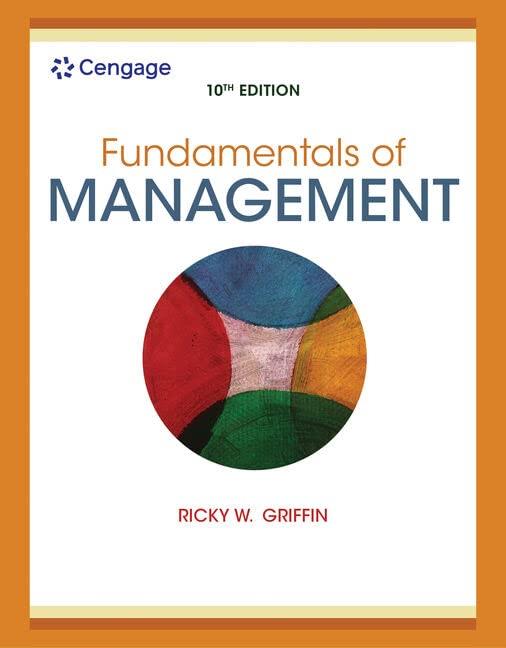Answered step by step
Verified Expert Solution
Question
1 Approved Answer
Now let's examine the impact of asymmetric information on the credit market equilibrium. Specifically, in this question we assume that Anderson is not able
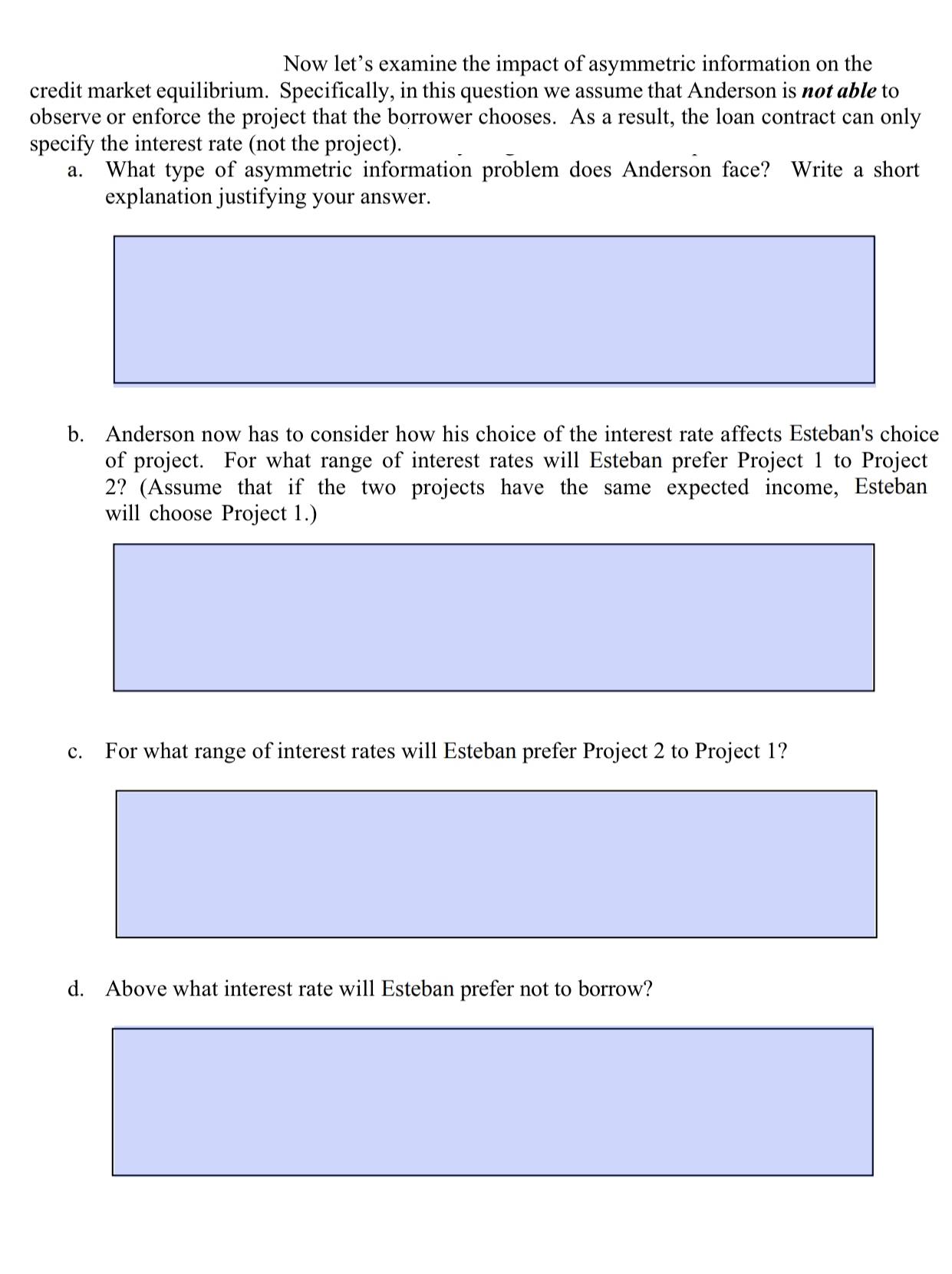
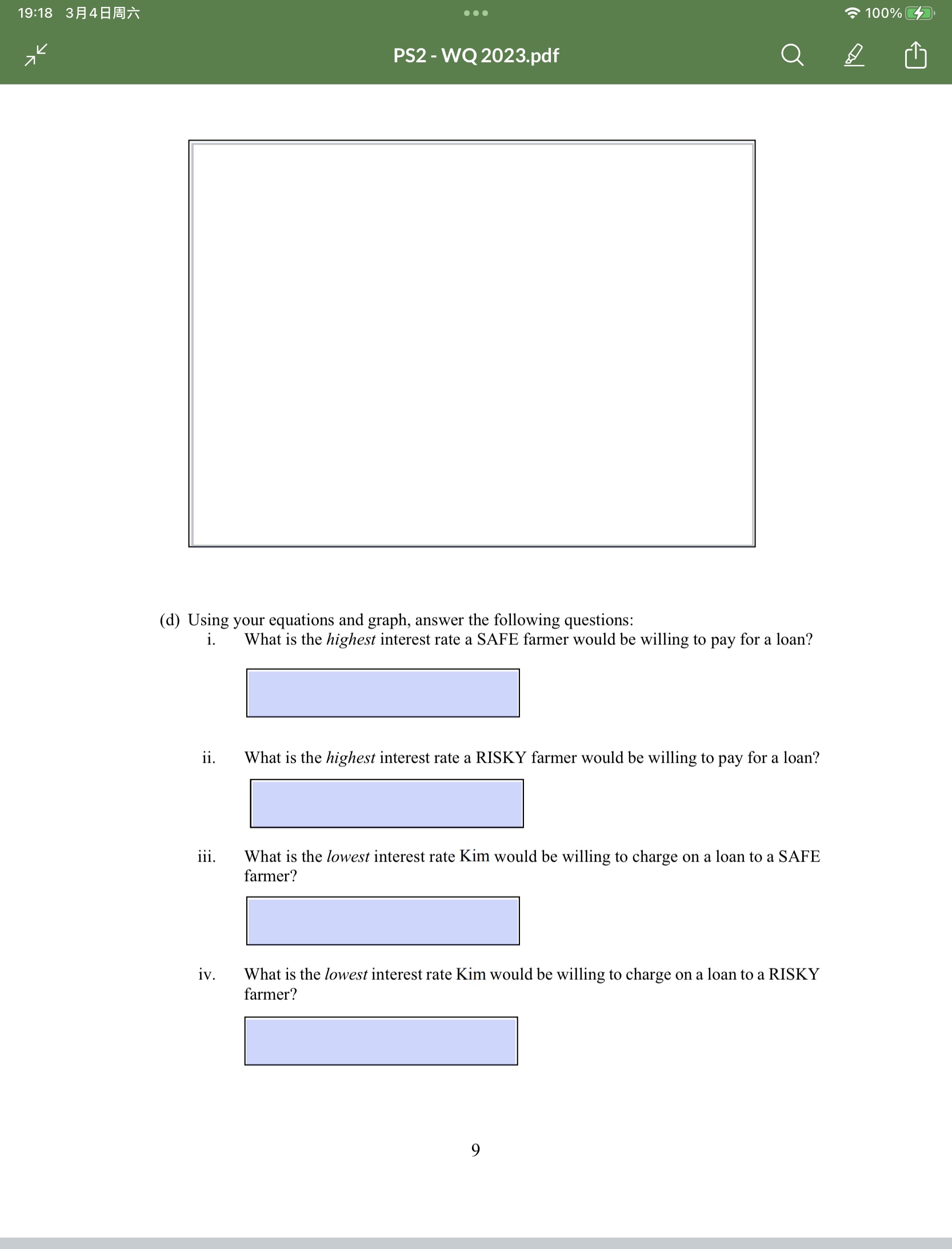
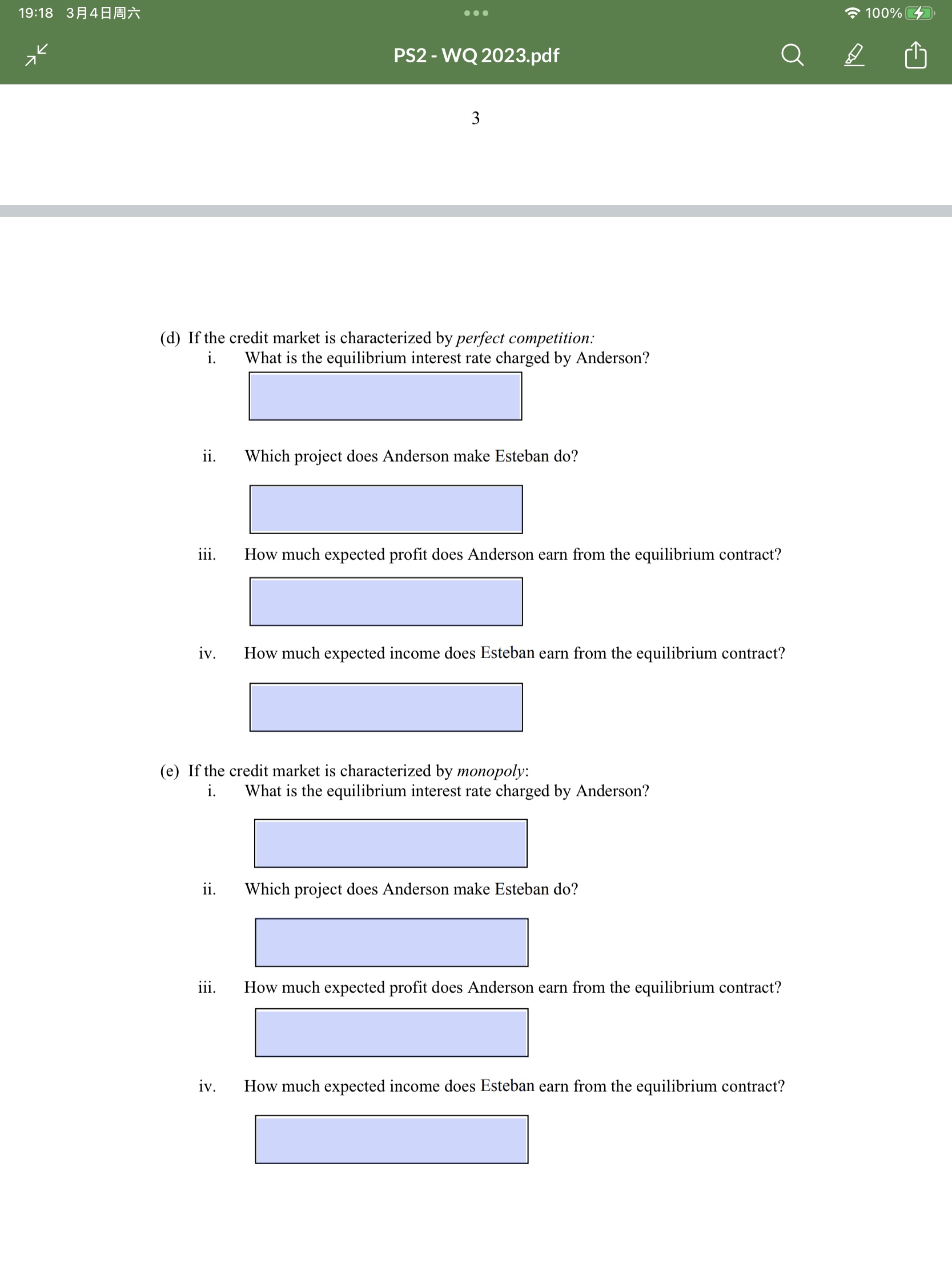
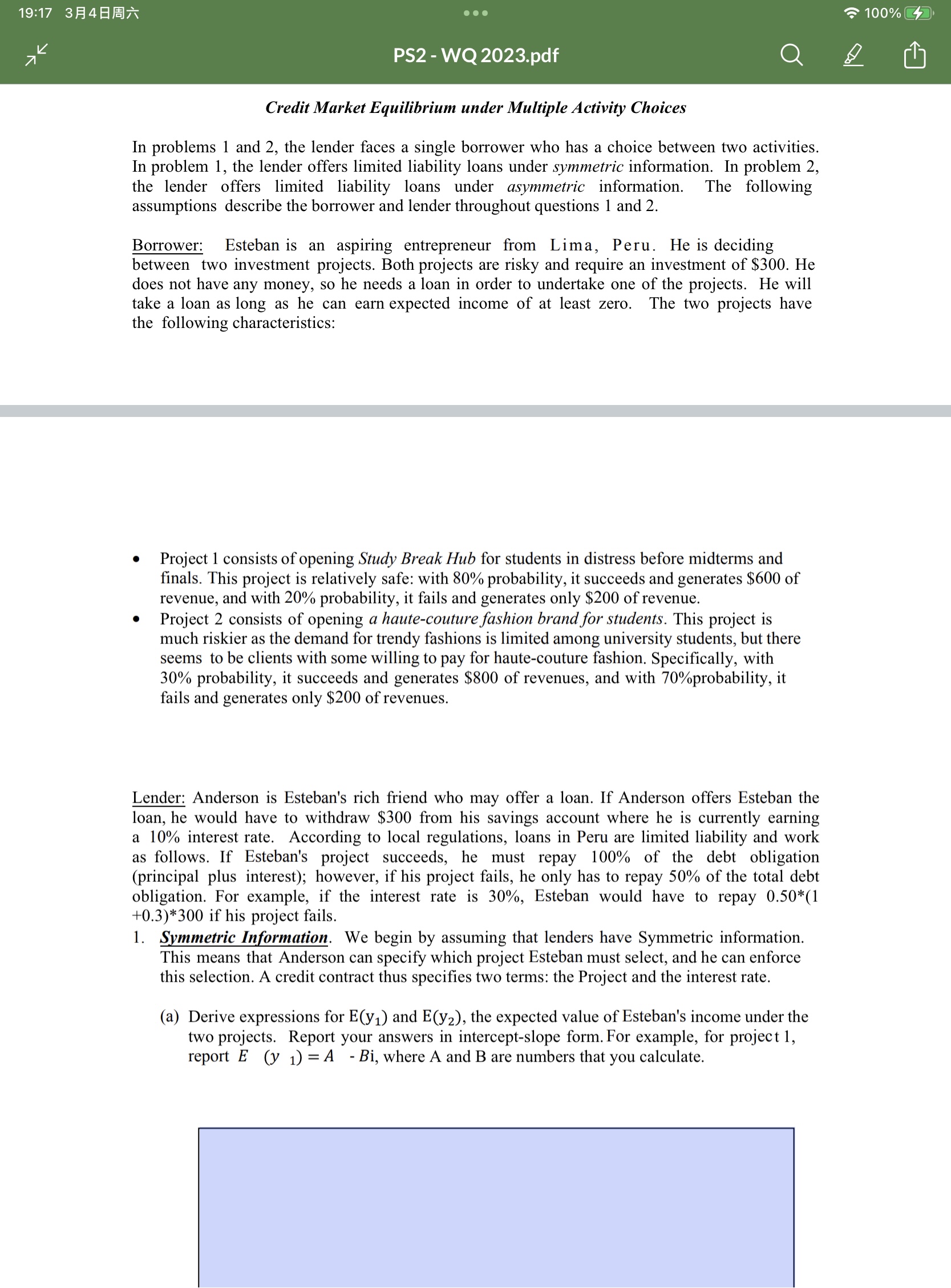

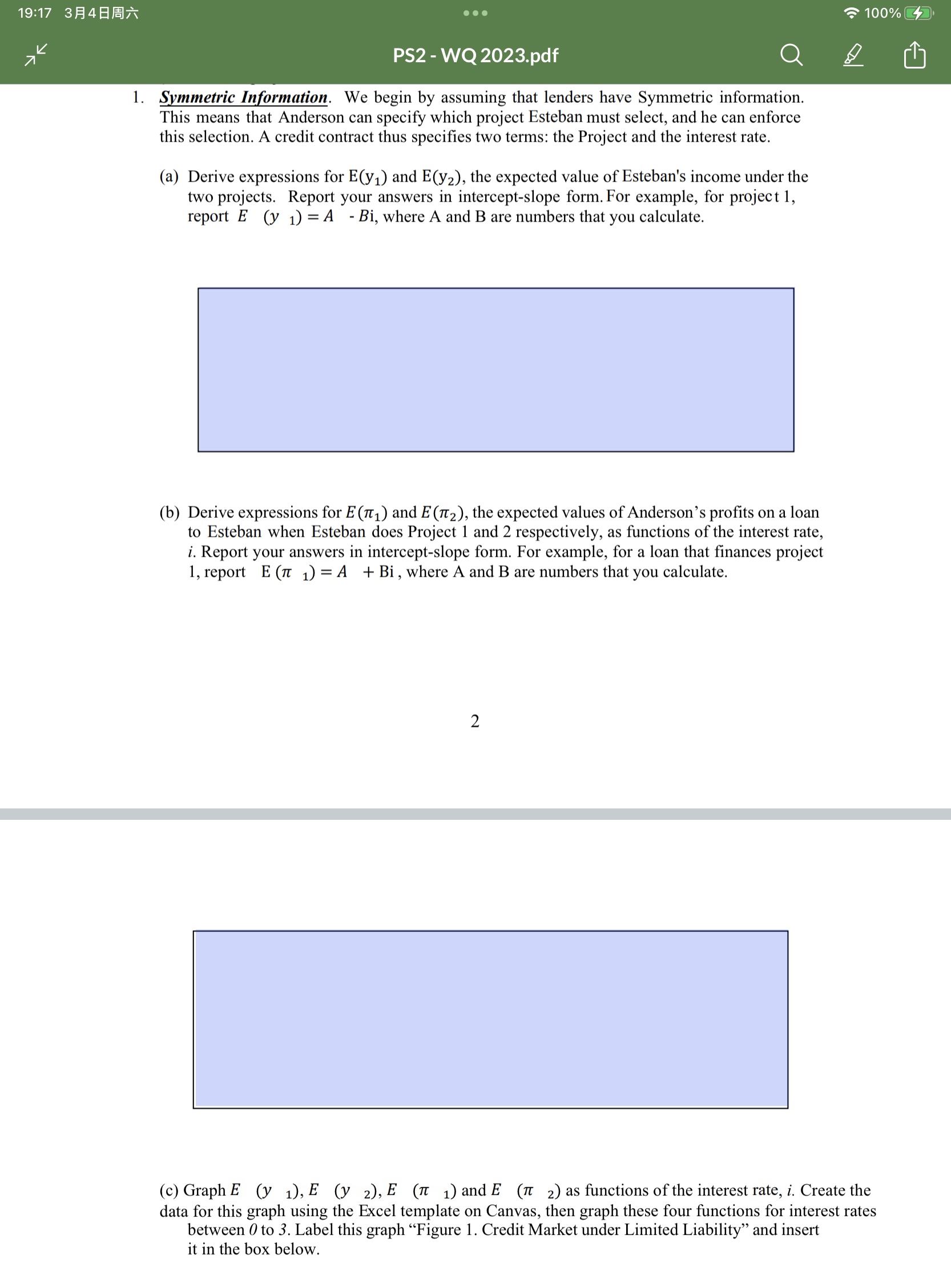
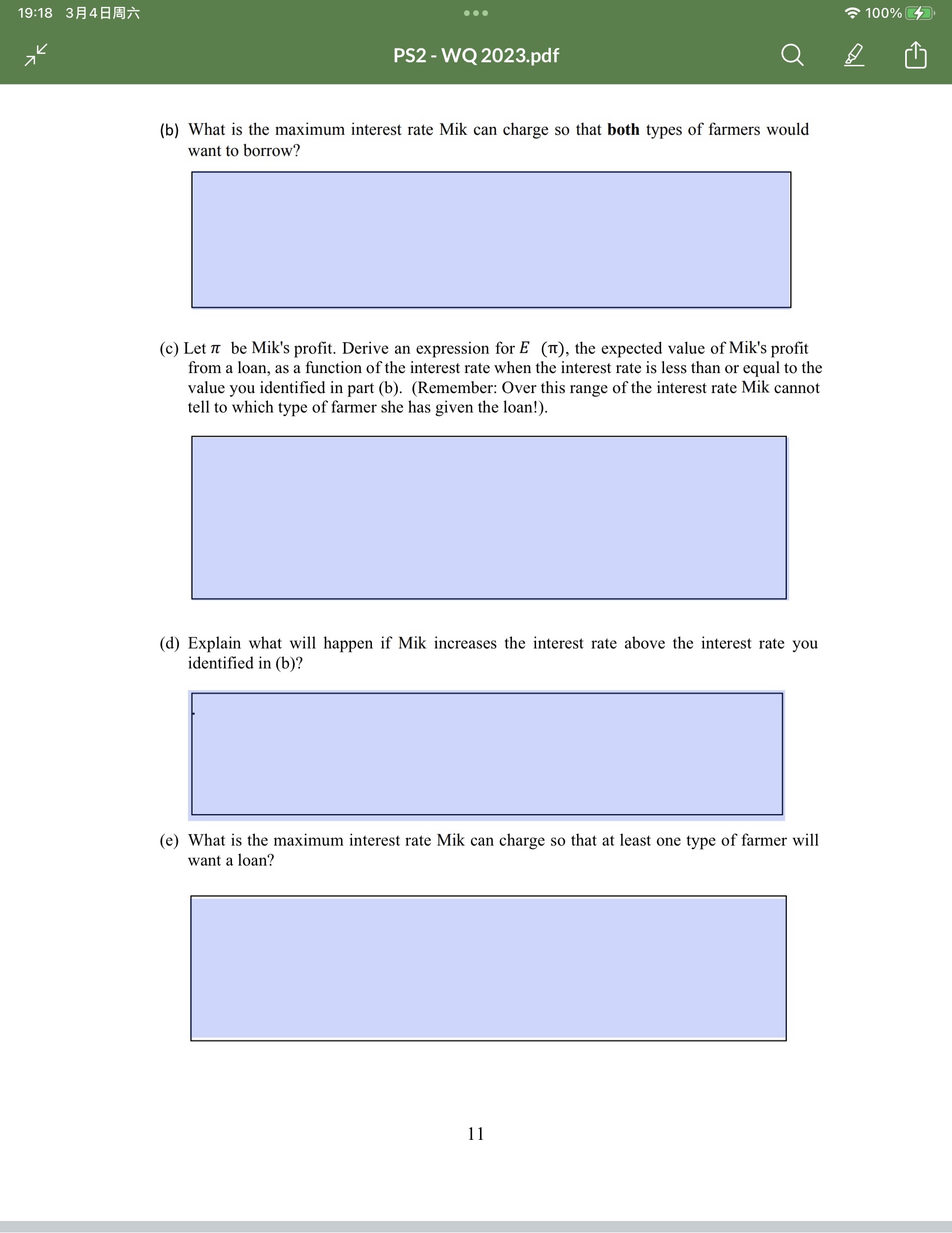
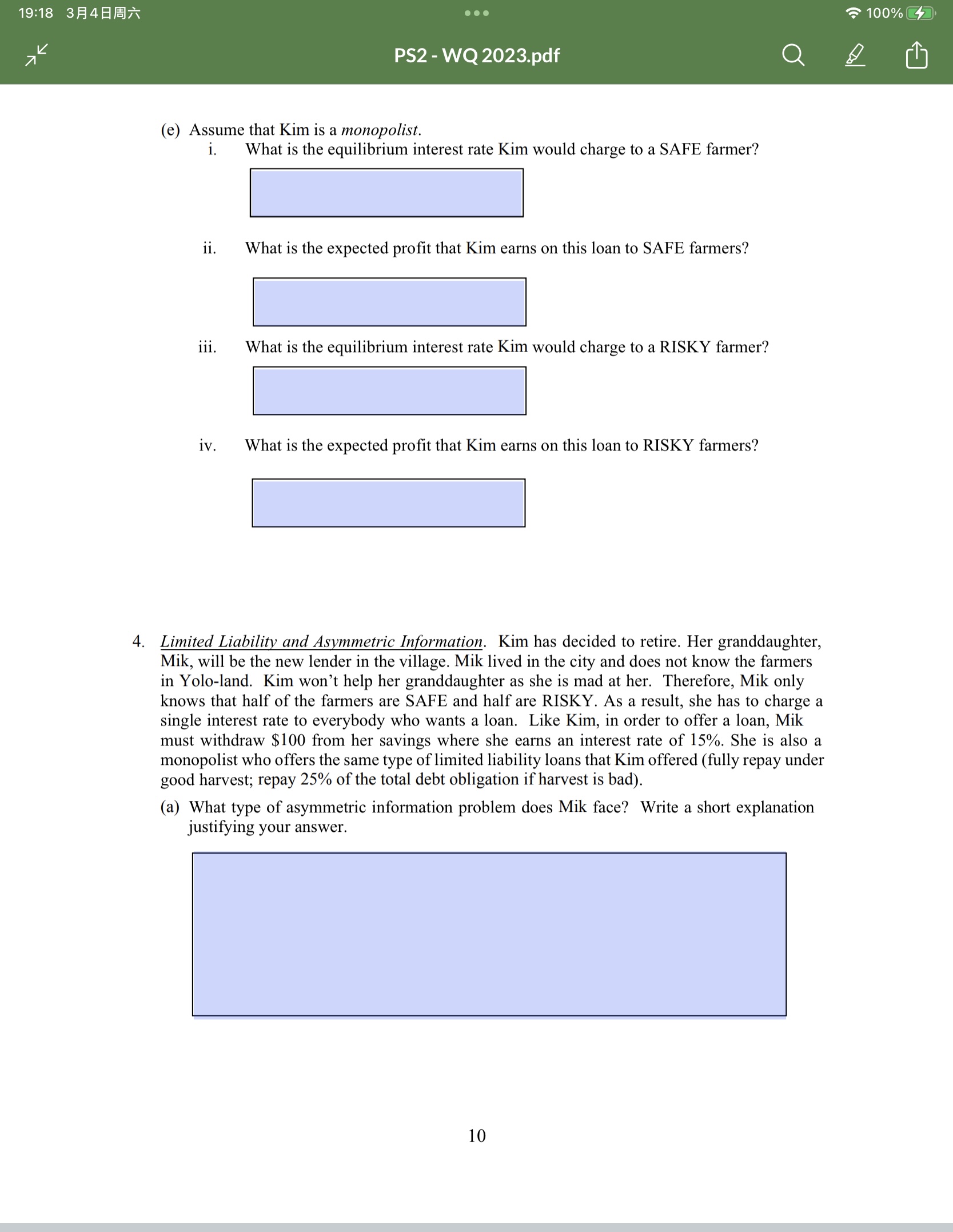
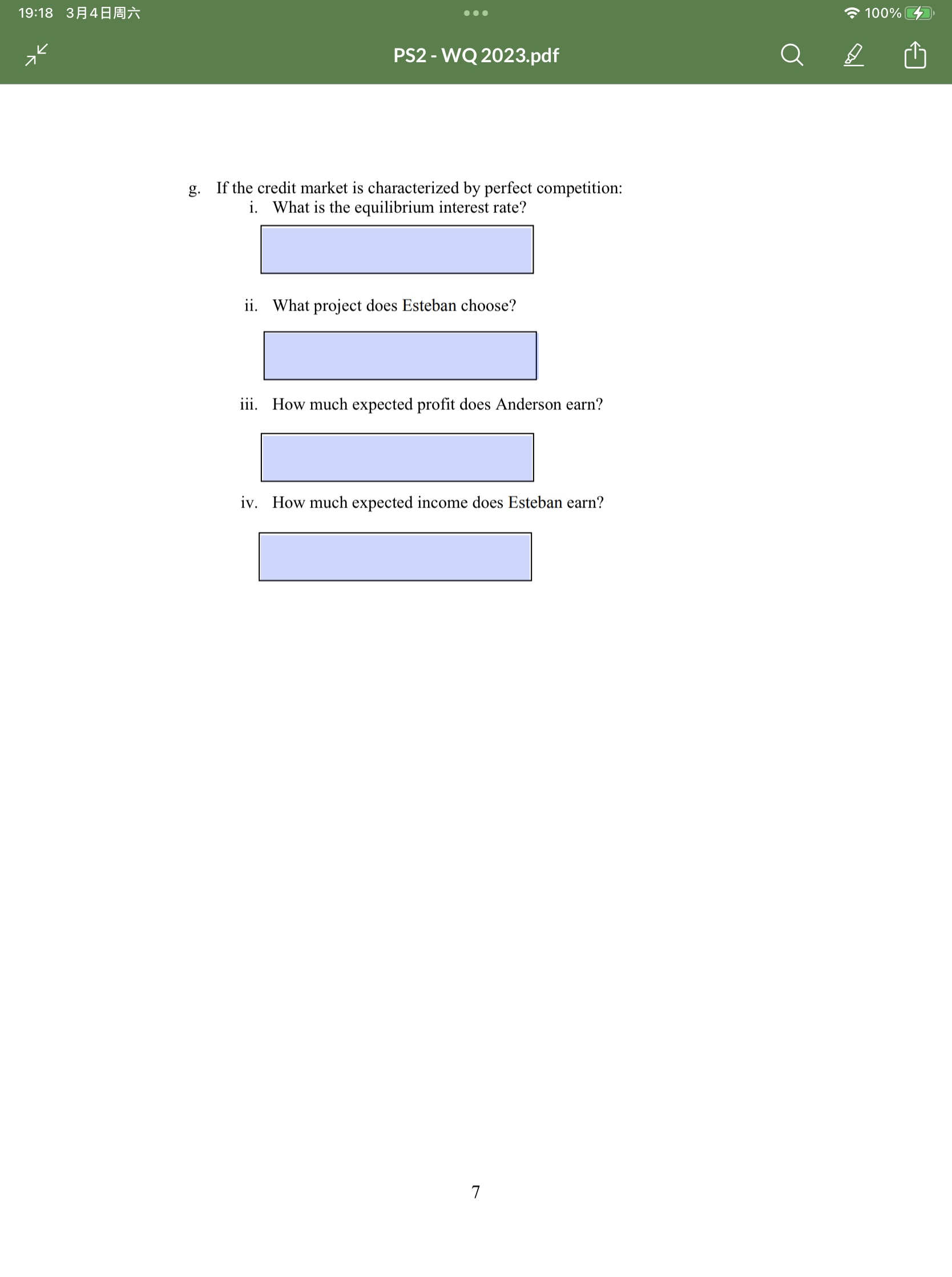
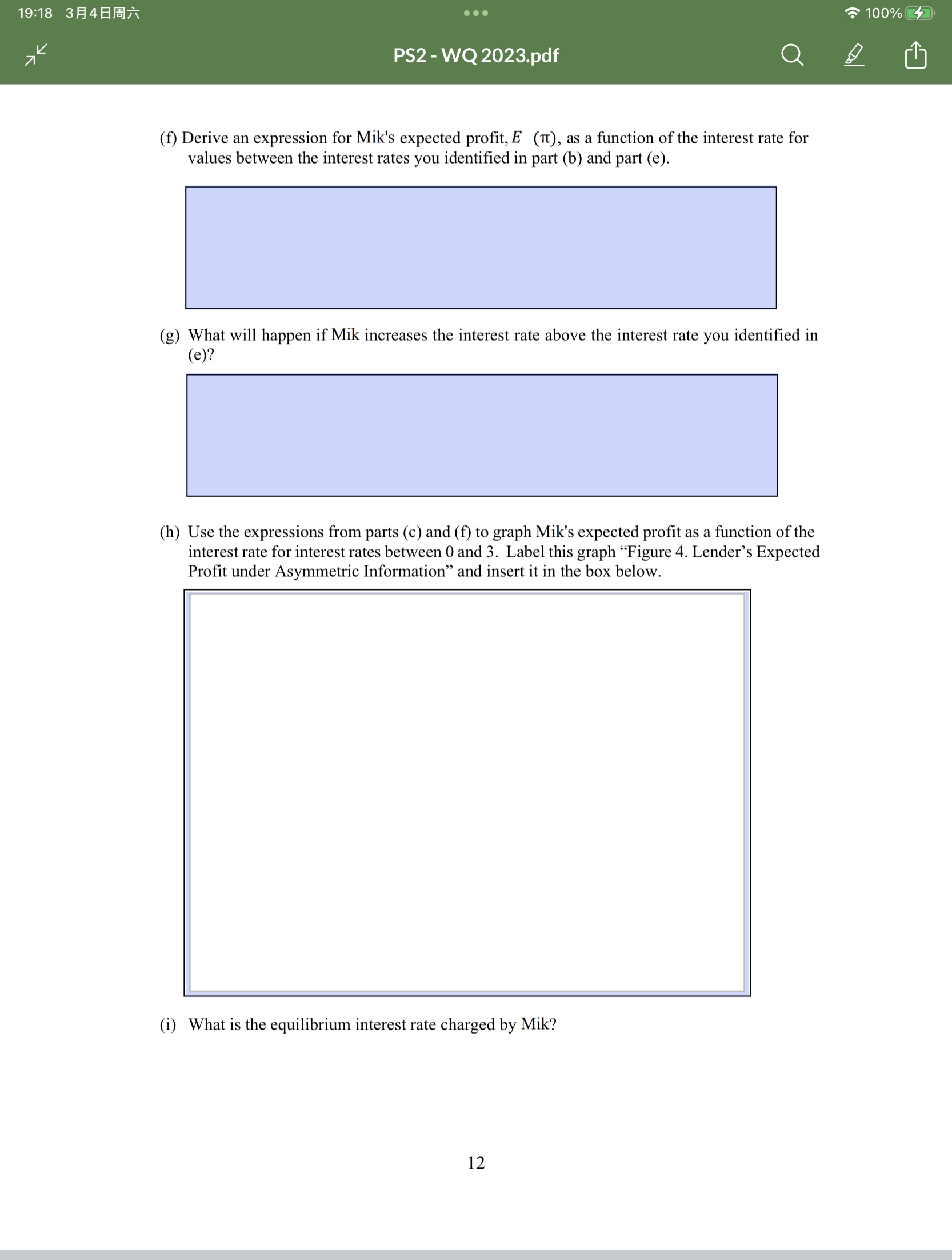
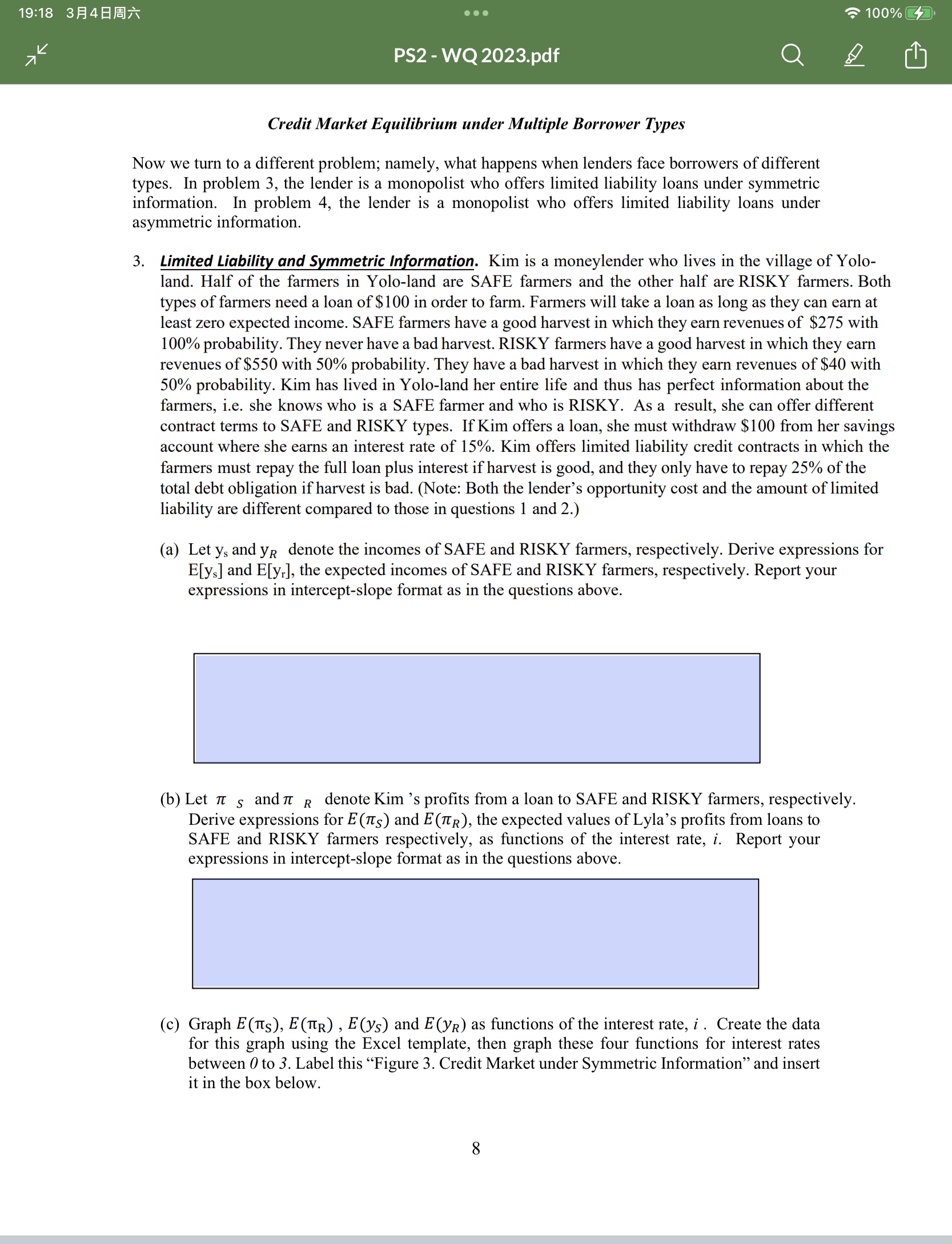
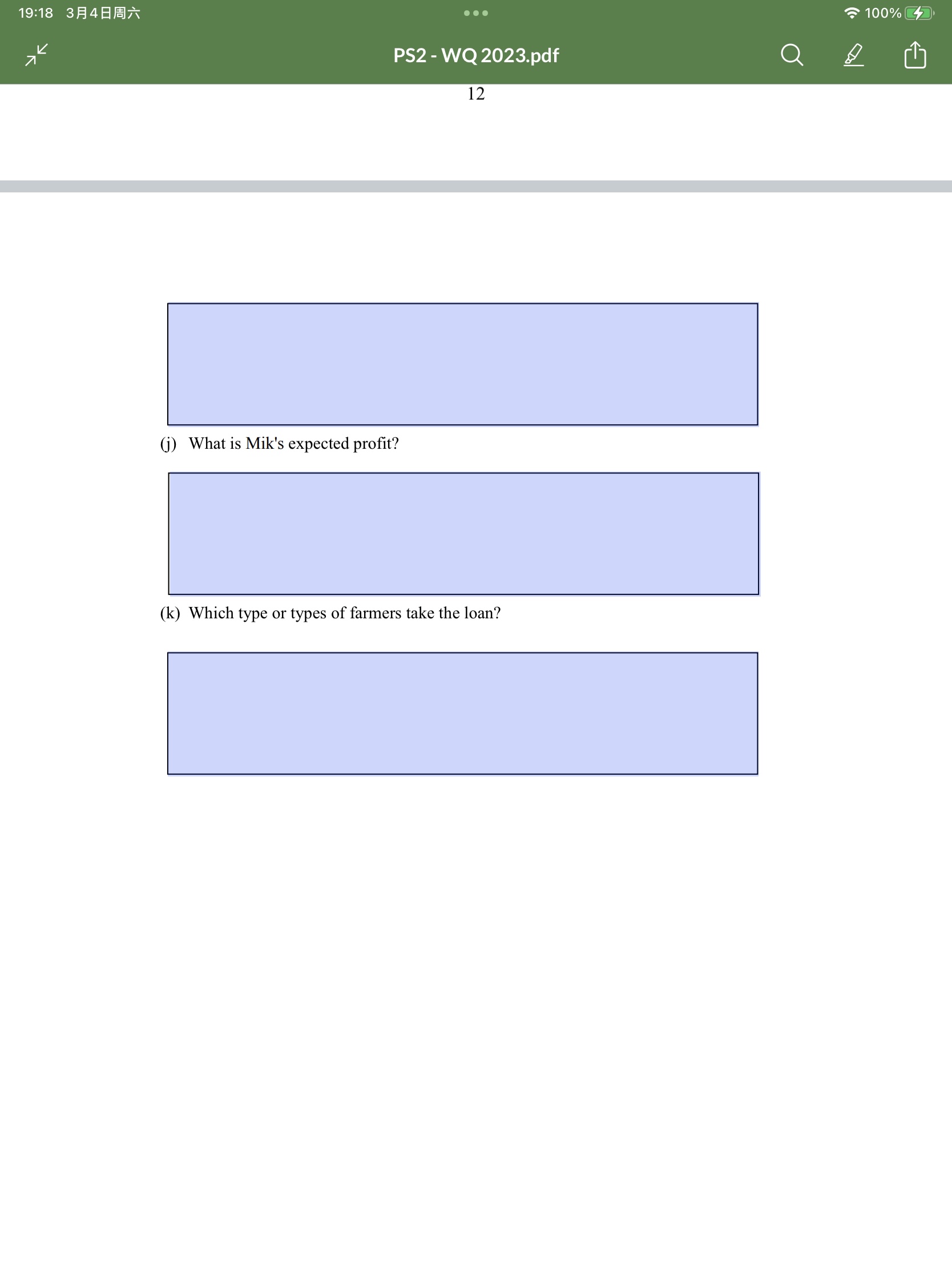
Now let's examine the impact of asymmetric information on the credit market equilibrium. Specifically, in this question we assume that Anderson is not able to observe or enforce the project that the borrower chooses. As a result, the loan contract can only specify the interest rate (not the project). a. What type of asymmetric information problem does Anderson face? Write a short explanation justifying your answer. b. Anderson now has to consider how his choice of the interest rate affects Esteban's choice of project. For what range of interest rates will Esteban prefer Project 1 to Project 2? (Assume that if the two projects have the same expected income, Esteban will choose Project 1.) C. For what range of interest rates will Esteban prefer Project 2 to Project 1? d. Above what interest rate will Esteban prefer not to borrow? 19:18 34 7 100% PS2-WQ 2023.pdf (d) Using your equations and graph, answer the following questions: i. What is the highest interest rate a SAFE farmer would be willing to pay for a loan? ii. What is the highest interest rate a RISKY farmer would be willing to pay for a loan? iii. What is the lowest interest rate Kim would be willing to charge on a loan to a SAFE farmer? iv. What is the lowest interest rate Kim would be willing to charge on a loan to a RISKY farmer? 9 19:18 34 7 K 100% PS2 - WQ 2023.pdf 3 (d) If the credit market is characterized by perfect competition: What is the equilibrium interest rate charged by Anderson? i. ii. Which project does Anderson make Esteban do? iii. How much expected profit does Anderson earn from the equilibrium contract? iv. How much expected income does Esteban earn from the equilibrium contract? (e) If the credit market is characterized by monopoly: i. What is the equilibrium interest rate charged by Anderson? ii. Which project does Anderson make Esteban do? iii. How much expected profit does Anderson earn from the equilibrium contract? iv. How much expected income does Esteban earn from the equilibrium contract? 19:17 34 K 7 PS2 - WQ 2023.pdf Credit Market Equilibrium under Multiple Activity Choices In problems 1 and 2, the lender faces a single borrower who has a choice between two activities. In problem 1, the lender offers limited liability loans under symmetric information. In problem 2, the lender offers limited liability loans under asymmetric information. The following assumptions describe the borrower and lender throughout questions 1 and 2. Borrower: Esteban is an aspiring entrepreneur from Lima, Peru. He is deciding between two investment projects. Both projects are risky and require an investment of $300. He does not have any money, so he needs a loan in order to undertake one of the projects. He will take a loan as long as he can earn expected income of at least zero. The two projects have the following characteristics: Project 1 consists of opening Study Break Hub for students in distress before midterms and finals. This project is relatively safe: with 80% probability, it succeeds and generates $600 of revenue, and with 20% probability, it fails and generates only $200 of revenue. Project 2 consists of opening a haute-couture fashion brand for students. This project is much riskier as the demand for trendy fashions is limited among university students, but there seems to be clients with some willing to pay for haute-couture fashion. Specifically, with 30% probability, it succeeds and generates $800 of revenues, and with 70% probability, it fails and generates only $200 of revenues. Lender: Anderson is Esteban's rich friend who may offer a loan. If Anderson offers Esteban the loan, he would have to withdraw $300 from his savings account where he is currently earning a 10% interest rate. According to local regulations, loans in Peru are limited liability and work as follows. If Esteban's project succeeds, he must repay 100% of the debt obligation (principal plus interest); however, if his project fails, he only has to repay 50% of the total debt obligation. For example, if the interest rate is 30%, Esteban would have to repay 0.50*(1 +0.3)*300 if his project fails. 1. Symmetric Information. We begin by assuming that lenders have Symmetric information. This means that Anderson can specify which project Esteban must select, and he can enforce this selection. A credit contract thus specifies two terms: the Project and the interest rate. (a) Derive expressions for E(y) and E(Y2), the expected value of Esteban's income under the two projects. Report your answers in intercept-slope form. For example, for project 1, report E (y 1) = A Bi, where A and B are numbers that you calculate. 100% 19:18 34 7 PS2-WQ 2023.pdf e. Use your answers from parts b - d to graph Anderson's expected profit as a function of the interest rate for interest rates between 0 and 3. Again, use the Excel template provided to make the graph and then insert it in the box below. Label this "Figure 2: Lender Expected Profit under Asymmetric Information" f. If the credit market is characterized by monopoly: i. What is the equilibrium interest rate? ii. Which project does Esteban choose? iii. How much expected profit does Anderson earn? iv. How much expected income does Esteban earn? 6 100% 19:17 34 K PS2-WQ 2023.pdf 1. Symmetric Information. We begin by assuming that lenders have Symmetric information. This means that Anderson can specify which project Esteban must select, and he can enforce this selection. A credit contract thus specifies two terms: the Project and the interest rate. (a) Derive expressions for E(y) and E(Y2), the expected value of Esteban's income under the two projects. Report your answers in intercept-slope form. For example, for project 1, report E (y 1) = A Bi, where A and B are numbers that you calculate. (b) Derive expressions for E() and E(2), the expected values of Anderson's profits on a loan to Esteban when Esteban does Project 1 and 2 respectively, as functions of the interest rate, i. Report your answers in intercept-slope form. For example, for a loan that finances project 1, report E ( 1) = A + Bi, where A and B are numbers that you calculate. 2 100% (c) Graph E (y 1), E (y 2), E ( 1) and E ( 2) as functions of the interest rate, i. Create the data for this graph using the Excel template on Canvas, then graph these four functions for interest rates between 0 to 3. Label this graph "Figure 1. Credit Market under Limited Liability and insert it in the box below. 19:18 34 7 PS2-WQ 2023.pdf (b) What is the maximum interest rate Mik can charge so that both types of farmers would want to borrow? (c) Let be Mik's profit. Derive an expression for E (), the expected value of Mik's profit from a loan, as a function of the interest rate when the interest rate is less than or equal to the value you identified in part (b). (Remember: Over this range of the interest rate Mik cannot tell to which type of farmer she has given the loan!). (d) Explain what will happen if Mik increases the interest rate above the interest rate you identified in (b)? (e) What is the maximum interest rate Mik can charge so that at least one type of farmer will want a loan? 11 100% 19:18 34 K 7 PS2 - WQ 2023.pdf (e) Assume that Kim is a monopolist. i. What is the equilibrium interest rate Kim would charge to a SAFE farmer? ii. What is the expected profit that Kim earns on this loan to SAFE farmers? 111. What is the equilibrium interest rate Kim would charge to a RISKY farmer? iv. What is the expected profit that Kim earns on this loan to RISKY farmers? 100% 4. Limited Liability and Asymmetric Information. Kim has decided to retire. Her granddaughter, Mik, will be the new lender in the village. Mik lived in the city and does not know the farmers in Yolo-land. Kim won't help her granddaughter as she is mad at her. Therefore, Mik only knows that half of the farmers are SAFE and half are RISKY. As a result, she has to charge a single interest rate to everybody who wants a loan. Like Kim, in order to offer a loan, Mik must withdraw $100 from her savings where she earns an interest rate of 15%. She is also a monopolist who offers the same type of limited liability loans that Kim offered (fully repay under good harvest; repay 25% of the total debt obligation if harvest is bad). (a) What type of asymmetric information problem does Mik face? Write a short explanation justifying your answer. 10 10 19:18 34 7 K 100% PS2 - WQ 2023.pdf g. If the credit market is characterized by perfect competition: i. What is the equilibrium interest rate? ii. What project does Esteban choose? iii. How much expected profit does Anderson earn? iv. How much expected income does Esteban earn? 7 19:18 34 7 PS2-WQ 2023.pdf (f) Derive an expression for Mik's expected profit, E (), as a function of the interest rate for values between the interest rates you identified in part (b) and part (e). 100% (g) What will happen if Mik increases the interest rate above the interest rate you identified in (e)? (h) Use the expressions from parts (c) and (f) to graph Mik's expected profit as a function of the interest rate for interest rates between 0 and 3. Label this graph "Figure 4. Lender's Expected Profit under Asymmetric Information" and insert it in the box below. (i) What is the equilibrium interest rate charged by Mik? 12 12 19:18 34 K 7 PS2 - WQ 2023.pdf 100% Credit Market Equilibrium under Multiple Borrower Types Now we turn to a different problem; namely, what happens when lenders face borrowers of different types. In problem 3, the lender is a monopolist who offers limited liability loans under symmetric information. In problem 4, the lender is a monopolist who offers limited liability loans under asymmetric information. 3. Limited Liability and Symmetric Information. Kim is a moneylender who lives in the village of Yolo- land. Half of the farmers in Yolo-land are SAFE farmers and the other half are RISKY farmers. Both types of farmers need a loan of $100 in order to farm. Farmers will take a loan as long as they can earn at least zero expected income. SAFE farmers have a good harvest in which they earn revenues of $275 with 100% probability. They never have a bad harvest. RISKY farmers have a good harvest in which they earn revenues of $550 with 50% probability. They have a bad harvest in which they earn revenues of $40 with 50% probability. Kim has lived in Yolo-land her entire life and thus has perfect information about the farmers, i.e. she knows who is a SAFE farmer and who is RISKY. As a result, she can offer different contract terms to SAFE and RISKY types. If Kim offers a loan, she must withdraw $100 from her savings account where she earns an interest rate of 15%. Kim offers limited liability credit contracts in which the farmers must repay the full loan plus interest if harvest is good, and they only have to repay 25% of the total debt obligation if harvest is bad. (Note: Both the lender's opportunity cost and the amount of limited liability are different compared to those in questions 1 and 2.) (a) Let y, and YR denote the incomes of SAFE and RISKY farmers, respectively. Derive expressions for E[y] and E[yr], the expected incomes of SAFE and RISKY farmers, respectively. Report your expressions in intercept-slope format as in the questions above. S (b) Let and R denote Kim's profits from a loan to SAFE and RISKY farmers, respectively. Derive expressions for E(s) and E(TR), the expected values of Lyla's profits from loans to SAFE and RISKY farmers respectively, as functions of the interest rate, i. Report your expressions in intercept-slope format as in the questions above. (c) Graph E(s), E(TR), E(s) and E(YR) as functions of the interest rate, i. Create the data for this graph using the Excel template, then graph these four functions for interest rates between 0 to 3. Label this "Figure 3. Credit Market under Symmetric Information" and insert it in the box below. 8 19:18 34 7 K PS2 - WQ 2023.pdf 12 100% (j) What is Mik's expected profit? (k) Which type or types of farmers take the loan?
Step by Step Solution
There are 3 Steps involved in it
Step: 1
Lets tackle the questions step by step Problem Context Esteban an aspiring entrepreneur needs a loan to undertake one of two projects Anderson a poten...
Get Instant Access to Expert-Tailored Solutions
See step-by-step solutions with expert insights and AI powered tools for academic success
Step: 2

Step: 3

Ace Your Homework with AI
Get the answers you need in no time with our AI-driven, step-by-step assistance
Get Started


